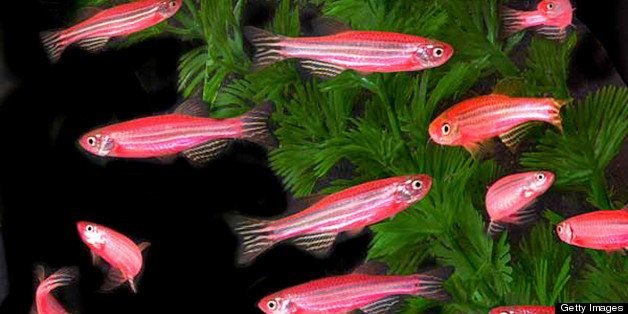
Over the past few years, I've been traveling around the country, investigating the future of animals. I went to Texas to meet the world's first cloned cat, steered a cyborg cockroach down a sidewalk in Massachusetts, petted a herd of genetically engineered goats in California, and flew to Florida to visit a flock of sandhill cranes outfitted with prosthetic legs.
These are the creatures that science is making possible. Thanks to advances in genetics, electronics, materials science, and veterinary medicine, we are now re-engineering and re-inventing other species. These breakthroughs in animal biotechnology could transform medicine, agriculture, and even warfare. But they could also hit much closer to home -- changing the very nature of our pets.
Here, a guide to four futuristic pets that could be coming soon to a family near you.
The Sequenced Pet
The revolution in genetics and genomics isn't just remaking human medicine -- it's reshaping veterinary medicine, too. Canine genomics is moving particularly fast, and scientists have identified the genes responsible for a number of doggy diseases, including hemophilia, cataracts, and a variety of metabolic disorders. Commercial labs are now making canine DNA tests available to the public; a dog owner can take a quick swipe of his pet's cheek cells and send the sample off for analysis.
These tests are poised to become powerful new veterinary tools, allowing us to better prepare for and manage the medical needs of our furry friends. Breeders are also beginning to use genetic tests -- which can reveal whether a seemingly healthy dog actually carries a hidden, disease-causing mutation -- to breed canines that are less prone to various ailments. It may not be long before puppies come with a certificate of "good genetic health" or a panel of DNA tests is a routine component of a puppy check-up. (Genetic testing of cats and horses is also becoming more common.)
The Hypoallergenic Pet
Though allergy-prone animal lovers may be able to find certain dogs and cats that don't trigger their symptoms, there's currently no such thing as a completely hypoallergenic pet. Genetic engineering could change that.
Allergies are triggered not by an animal's fur, but by certain proteins present in their saliva, skin, and urine. So to engineer a truly hypoallergenic pet, biologists will need to disable, or "knock out," the genes that code for these sneeze-inducing proteins. At least one company is already on the case; Felix Pets is reportedly working to engineer cats that are missing the gene that codes for Fel d 1, one of the proteins that causes allergic reactions in humans.
It remains to be seen, however, how disabling these genes will affect the animals' themselves; genetically engineered, hypoallergenic pets will only take off if scientists can demonstrate that the creatures live long, healthy lives.
The Cyborg Pet
Microchips have helped reunite many families with their lost pets. Injected just underneath the skin, the devices -- each about the size of a grain of rice -- come with unique serial numbers. When a pet goes missing, a vet can scan the microchip, look up the serial number in a central database, and locate the animal's owner.
But why settle for a microchip that merely identifies your pet when engineers have now created chips that do so much more? Destron Fearing, a company that specializes in animal tags and identification devices, now manufactures and sells "Bio-Thermo" microchips, which monitor the internal body temperature of the animals in which they're implanted. In the beginning, the chips were marketed primarily to livestock owners, but they are now also available for pets. Currently, taking a temperature reading requires using a specialized external scanner, but that may not always be the case. Imagine, for instance, networking one of these temperature-sensitive chips with your computer or smartphone; it may one day be possible to get an automatic notification if your pet has a fever, alerting you to potential illness or disease.
The Glowing Pet
The first glowing pets are already here. Since 2004, pet stores across the U.S. have been selling GloFish, which have been genetically engineered to fluoresce in shades of red, orange, green, blue and purple. Scientists created the fish by transferring genes from coral and sea anemones, which happen to glow naturally, into the bodies of zebrafish, which are normally covered in black-and-white stripes. With these foreign genes on board, the monochrome fish turn Technicolor.
Could glowing cats and dogs be in our future? There's no technical reason why not. In fact, scientists have already created them, transferring fluorescence genes into dog and cat embryos to create kittens that turn green and puppies that turn red under ultraviolet light. But will consumers want such creatures? On the one hand, neon cats and dogs seem far stranger and creepier than neon fish. On the other: What better way to brighten up a dark night than by curling up with your beloved creature companion and staring into his furry, green face?
Emily Anthes is a science journalist and the author of Frankenstein's Cat: Cuddling Up to Biotech's Brave New Beasts.